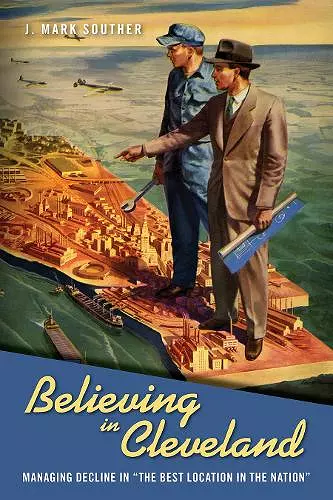Believing in Cleveland
Managing Decline in “The Best Location in the Nation”
Format:Hardback
Publisher:Temple University Press,U.S.
Published:3rd Nov '17
Currently unavailable, and unfortunately no date known when it will be back
This hardback is available in another edition too:
- Paperback£23.99(9781439913734)

Detractors have called it "The Mistake on the Lake." It was once America’s "Comeback City." According to author J. Mark Souther, Cleveland has long sought to defeat its perceived civic malaise. Believing in Cleveland chronicles how city leaders used imagery and rhetoric to combat and, at times, accommodate urban and economic decline.
Souther explores Cleveland's downtown revitalization efforts, its neighborhood renewal and restoration projects, and its fight against deindustrialization. He shows how the city reshaped its image when it was bolstered by sports team victories. But Cleveland was not always on the upswing. Souther places the city's history in the postwar context when the city and metropolitan area were divided by uneven growth. In the 1970s, the city-suburb division was wider than ever.
Believing in Cleveland recounts the long, difficult history of a city that entered the postwar period as America's sixth largest, then lost ground during a period of robust national growth. But rather than tell a tale of decline, Souther provides a fascinating story of resilience for what some folks called "The Best Location in the Nation."
"In tracing the evolving production of images designed to confirm Cleveland's continued vitality in spite of the urban crisis that enveloped it in the mid-twentieth century, J. Mark Souther unveils the complex relationship between revitalization and decline. By penetrating the unified façade of the city's growth coalition, he reveals how competing approaches and contested perceptions complicated both recovery and public confidence in its success. Believing in Cleveland tests our understanding of how urban stakeholders reacted to decline and offers considerable insight into the perils of addressing revitalization in an important Rust Belt city."—Howard Gillette Jr., Professor Emeritus of History, Rutgers University, and author of Camden after the Fall: Decline and Renewal in a Post-industrial City
"Believing in Cleveland makes an important contribution to urban policy scholarship. Instead of starkly alternating accounts of revitalization or decline, Souther shows that decline and resurgence have always coexisted in post–World War II metropolitan life. By including the downtown, residential neighborhoods, and industry in the same history—one that foregrounds citizens' best and worst efforts on behalf of their entire metropolis—this book upends clichés of monolithic, hollow boosterism and an artificial center/suburb divide. Cleveland offers a powerful story in its own right, but most U.S. cities will see themselves reflected in this illuminating mirror."
—Alison Isenberg, Professor of History, Princeton University, and author of Designing San Francisco: Art, Land, and Urban Renewal in the City by the Bay
"Believing in Cleveland is a powerful antidote to the simplistic, unidirectional narrative of decline that too often attends accounts of Rust Belt cities. Souther deftly interlaces stories of urban decay and revitalization, civic pessimism and optimism, despair over past mistakes and hope for a brighter future. Best of all, Souther traces these stories through real material spaces of the city. In the process, we see a wide range of actors at work and a city constantly grappling with its status in an urban nation. In this way, Believing in Cleveland sets a new standard for how we tell the story of postwar urban governance, municipal policy, and community development—a story where the richly layered interests of real people manifest in the streets, parks, plazas, and homes of the city."—Joseph Heathcott, Associate Professor of Urban Studies, The New School, and co-author (with Angela Dietz) of Capturing the City: Photographs from the Streets of St. Louis, 1900–1930
"Historian Souther's meticulously researched book reexamines and, in his own word, 'complicate[s]' the understanding of the efforts expended by city politicians, civic leaders, and economic development professionals in their attempts to slow or reverse urban decline since WWII.... Readers will wonder if any of the projects proposed but abandoned would have produced different outcomes. Throughout, Souther maintains a balanced, dispassionate tone.... Summing Up: Highly recommended."—Choice
"[A] dense, exhaustively researched history of simultaneous growth and decline in Cleveland from the 1940s to the 1980s.... [Souther's] considered findings make for multiple valuable contributions to the understanding of mid-century urbanism.... Souther's focus on the importance of perceptions of a city, by its citizens and by outsiders, is one of the prime contributions of this book.... By investigating perceptions and their influence, Souther excels in illuminating Cleveland’s recent history."—Journal of Urban Affairs
"Souther deals with Cleveland’s sad transformation and the attempts to reverse its fortunes in this deeply researched and well-written book.... [He] presents a nuanced and complex account of the city’s attempts at rebirth over several decades.... highly recommended."— Journal of American History
"In his finely detailed and meticulously researched study, [Souther] expertly traces the story of one beleaguered midwestern city’s initiatives to manage decline.... Souther’s work is a valuable resource. It deserves the serious attention of all students of urban America."—Indiana Magazine of History
"This kind of project offers important contributions to several subfields of U.S. urban historical scholarship. At one level, Souther’s book provides a rich survey of local economic and policy history, including a source-intensive demonstration of the fractured rather than monolithic nature of postwar metropolitan growth coalitions. At another and perhaps more innovative level, it adds marvelously to the growing scholarly turn toward issues of urban representation and narrative. Indeed, Believing in Cleveland is, in large measure, a sustained close reading of a particular cluster of representational texts (growth coalition revitalization narratives) and the conflicted ways in which various interpretive communities—among others, business tycoons, white suburbanites, downtown theatergoers, and African American neighborhood activists—responded to them."—American Historical Review
ISBN: 9781439913727
Dimensions: 229mm x 152mm x 23mm
Weight: unknown
288 pages